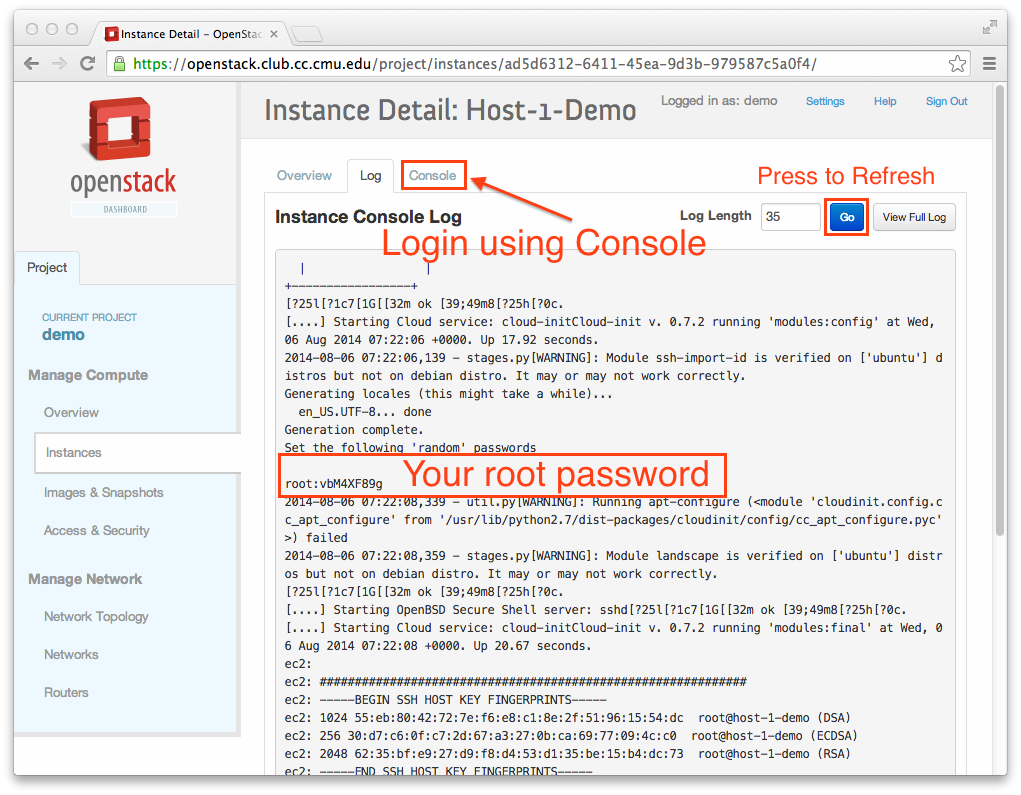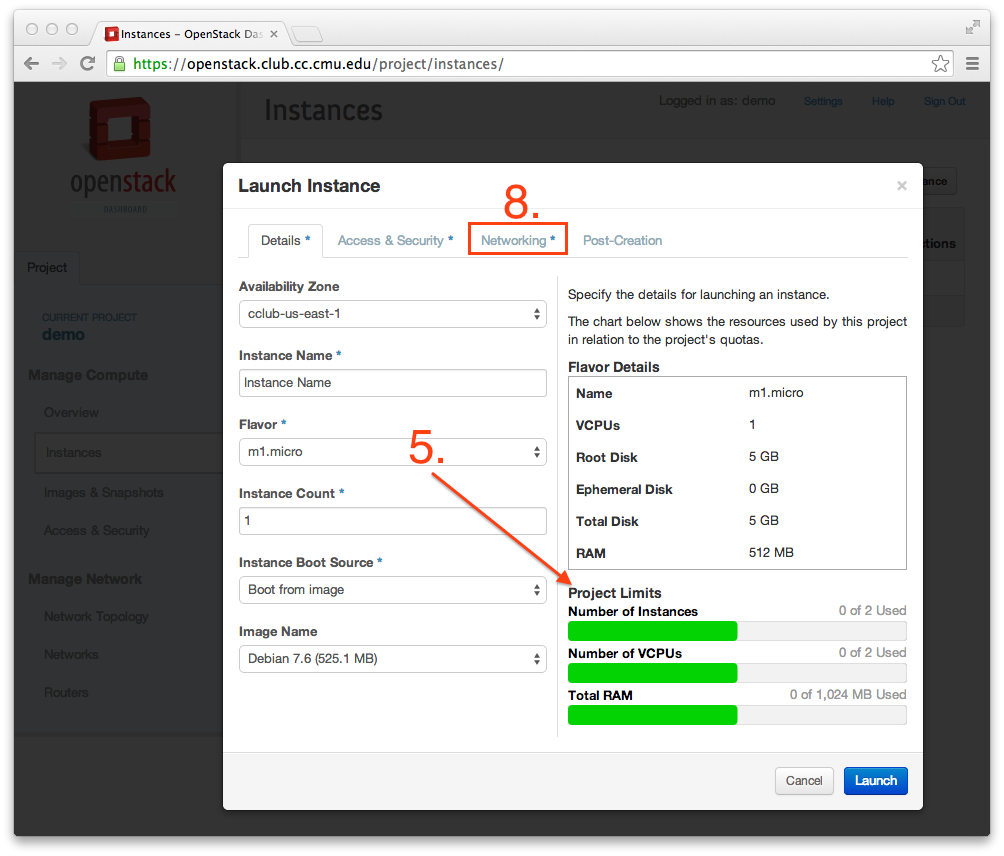| Deletions are marked like this. | Additions are marked like this. |
| Line 91: | Line 91: |
| The Log and the Console allows you to see the detailed status of your instance and perform management. |
The Log and the Console allows you to see the detailed status of your instance and perform remote management. '''Only when your instance has reached the ''Active'' state will the Log and Console will be available.''' You can access the console from clicking the instance name in the instance page, and choosing the '''Log''' or '''Console''' Tab respectively. Your `root` password will be printed out to the '''Log''' on first boot, you can use this password to login in the '''Console'''. Note that this log will only be cleared on reboot, and is readable by other members of the organization. So it is important to change your password using the `passwd` command |
This page is about using CCVM as a CMU student. For Computer Club members, see Projects/ccvms/Internal_Use. For information about the OpenStack infastructure, including maintenance and deployment information, see Projects/ccvms/Openstack
CCVM Project |
|
|
|
Type |
Contrib |
Platform |
|
Language |
Python |
Status |
Release Testing |
Launch Status |
Unplanned |
Contact |
sbaugh |
|
cpreseau |
|
ssosothi |
Website |
|
The CCVMs project aims to provide easy-to-obtain virtual machines to members of the CMU community. It utilizes the OpenStack framework to allow users to start their own instance, access the console, re-install and boot their system remotely through a web interface. The interface is available to everyone in the community authenticating as a CCVM OpenStack user.
Currently the CCVMs project uses running 4 hosts, with 3 hosts dedicated as Compute Nodes. Each of the Compute node is powered by 8 Core Intel(R) Xeon(R) CPU X5470 @ 3.33GHz with 6144 KB cache, and 32GB 667MHz DDR2 FBDIMM Ram.
Organizations can contact operations@club.cc.cmu.edu to request an organization account with a higher instance and performance quota. We make no guarantee for the recovery of data stored on the instances, please periodically backup your instances to a safe location.
Getting CCVM
You'll need an CCVM OpenStack User, so create one as follows:
If you have any problems, please talk to a member of Computer Club! There will usually be people who can help in IRC
Create an account
If you are a Computer Club member, see Projects/ccvms/Internal_Use.
Go to https://my.contrib.andrew.cmu.edu/ccvms/signup.php
After your account is created, you can login at https://openstack.club.cc.cmu.edu
Important note about new Instances
On the first boot of an instance based on the image "Debian 7.6":
Your root password will be printed out to the Log Tab.
Change this password by typing: passwd
You can use this to log in from the OpenStack web UI VNC client, which should be marked "Console".
SSH from outside CCVM
1 #First, on the ccvm instance, from the "Console" tab
2 ssh -R 15251:localhost:22 <YourAndrewID>@unix1.andrew.cmu.edu
3
4 #Then, on unix1.andrew.cmu.edu:
5 ssh localhost -p 15251
Basic CCVM Tasks
OpenStack is fairly intuitive, but web UI, CLI, and API documentation can be found at: http://docs.openstack.org/user-guide/
You can use CCVM instance for anything, as long as you don't violate the CMU computing policy
Launching an instance
Here are a step by step guide on how to launch an instance
Goto the Instance page from the sidebar link
Click + Launch Instance to bring up the instance configuration dialog, see Figure
Make sure that the Availability Zone is cclub-east-1
- Type your instance name, and make sure
- Choose your instance Flavor. The bars on the right side will show you how close you are to your max quota
In the Instance Boot Source menu, choose Boot from image
In the Image Name menu, choose Debian 7.6
Click on the top Networking * Tab
Click the blue + or Drag ccvm-net into the blue zone
- Click Launch
Accessing the Log and Console
The Log and the Console allows you to see the detailed status of your instance and perform remote management.
Only when your instance has reached the Active state will the Log and Console will be available.
You can access the console from clicking the instance name in the instance page, and choosing the Log or Console Tab respectively. Your root password will be printed out to the Log on first boot, you can use this password to login in the Console. Note that this log will only be cleared on reboot, and is readable by other members of the organization. So it is important to change your password using the passwd command
Adding Firewall Exceptions
To allow other services (web servers/game servers) on your instance to accept connection, you must add an exception to the instance firewall
TBA
Port Forwarding
You can use ssh to port forward your server's port to one of andrew unix's machine. You'll lose the connection when the unix machine reboot at 4am.
Join Computer Club today to get access to unix machines that do not reboot
TBA
Organization related CCVM Tasks
Organizations can perform additional tasks in addition to the basic tasks
Switching to the Organization project
If you are a part of an organization, you can switch over to manage the organization's project.
TBA
Allocating a public IP
The cluster only has 23 Public IP address, so please contact operations@club.cc.cmu.edu to request a public address.
TBA
Allocations
Once you've created an CCVM OpenStack account, you'll be given the community level of CPU, RAM, and VM allocation. As we move on with this project, we may be able to increase your allocation as demand increases and we acquire more hardware.
We also make special allocations for anyone who contact us with a legitimate use case.
Our standard VM Flavors are as follows:
Flavor Name |
VCPUs |
RAM |
Root Disk |
m1.micro |
1 |
512MB |
5GB |
m1.tiny |
1 |
1024MB |
10GB |
m1.small |
2 |
512MB |
10GB |
m1.medium |
2 |
1024MB |
15GB |
m1.large |
4 |
2048MB |
20GB |
Community Account
2 Instances, 2 VCPU, 1 GB Ram
Flavors available:
- m1.micro
- m1.tiny
- m1.small
Organization Account
4 Instances, 4 VCPU, 2 GB Ram, 1 Public IP Address
Flavors available:
- m1.micro
- m1.tiny
- m1.small
- m1.medium
- m1.large
Organizational limits are flexible and we can adjust the limits depending on your requirements
To be finalized


